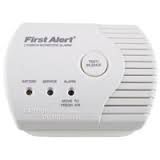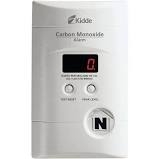Placement of CO Detectors

Placement of CO detectors can monitor exposure levels in a home if they are installed in the correct locations.
Do Not place them:
- directly above or beside fuel-burning appliances, as appliances may emit a small amount of carbon monoxide upon start-up;
- within 15 feet of heating and cooking appliances, or in or near very humid areas, such as bathrooms;
- within 5 feet of kitchen stoves and ovens, or near areas locations where household chemicals and bleach are stored (store such chemicals away from bathrooms and kitchens, whenever possible);
- in garages, kitchens, furnace rooms, or in any extremely dusty, dirty, humid, or greasy areas;
- in direct sunlight, or in areas subjected to temperature extremes. These include unconditioned crawlspaces, unfinished attics, un-insulated or poorly insulated ceilings, and porches;
- in turbulent air near ceiling fans, heat vents, air conditioners, fresh-air returns, or open windows. Blowing air may prevent carbon monoxide from reaching the CO sensors.
Do place CO detectors:
- within 10 feet of each bedroom door and near all sleeping areas, where it can wake sleepers. The Consumer Product Safety Commission (CPSC) and Underwriters Laboratories (UL) recommend that every home have at least one carbon monoxide detector for each floor of the home, and within hearing range of each sleeping area;
- on every floor of your home, including the basement (source: International Association of Fire Chiefs/IAFC);
- near or over any attached garage. Carbon monoxide detectors are affected by excessive humidity and by close proximity to gas stoves (source: City of New York);
- near, but not directly above, combustion appliances, such as furnaces, water heaters, and fireplaces, and in the garage (source: UL); and
- on the ceiling in the same room as permanently installed fuel-burning appliances, and centrally located on every habitable level, and in every HVAC zone of the building (source: National Fire Protection Association 720). This rule applies to commercial buildings as well.Home Run Inspections, LLCOklahoma: 405-905-9175Info@HomeRunInspections.com
We Cover All the Bases!
Serving: Oklahoma City, Norman, Yukon, Edmond, Piedmont, Bethany, El Reno, Tuttle, Mustang, Moore, Norman, Midwest City, Del City, Choctaw, McCloud, Shawnee, Harrah, Newalla, Jones, and more.
Schedule Your Inspections Online at:
Like us on FaceBook
Follow us on Twitter
Follow us on Instagram


